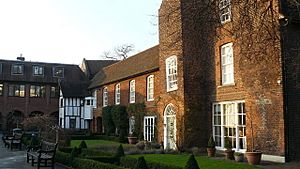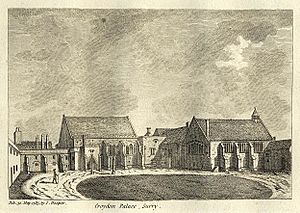Croydon Palace facts for kids
Croydon Palace is a very old building in Croydon, which is now part of south London. For over 500 years, it was the summer home for the Archbishop of Canterbury. Important people like King Henry III and Queen Elizabeth I often visited. Today, the building is called "Old Palace". It is used as the Old Palace School, a private school for girls. The school is part of the Whitgift Foundation.
Contents
Exploring Croydon Palace's Past
The land in Croydon has been linked to the Archbishop of Canterbury since the late Saxon times. Records show buildings here even before the year 960. The palace you see today was mostly built in the 1400s and 1500s.
The Great Hall and Its Features
The large Great Hall was likely built by Archbishop Stafford in the 1400s. It has a two-story entrance porch from the late 1300s. The lower part of the porch has a cool arched ceiling. Inside the hall, you can see a beautiful wooden roof from the 1500s. There are also interesting windows and an old Gothic-style inner porch.
Later, in the 1600s, Archbishops Laud and Juxon updated parts of the Great Hall. They also rebuilt the chapel.
Inside the Palace Rooms
To the west of the Great Hall are the fancy state apartments. One of these is the Guard Room, which is now the school library. This room might have been built by Archbishop Arundel (who was Archbishop from 1396 to 1414). It has a special arched roof with carved stone supports. There's also a unique oriel window that sticks out from the wall.
Other rooms in the palace have old wooden panels and fireplaces. The chapel has nice wooden stalls from the 1600s and a detailed corner gallery. The beautiful altar rails from the chapel are now in the Guard Room. The outside of the palace is made of stone or red brick. It has old stone windows or Georgian sash windows.
Famous Visitors and Residents
The Archbishops had a very important connection to Croydon. Many of them helped the local area a lot. Six Archbishops are buried nearby at Croydon Minster. These include Edmund Grindal, John Whitgift, Gilbert Sheldon, William Wake, John Potter, and Thomas Herring.
Archbishop Whitgift was the first to call it a "palace". He liked Croydon because it was a "sweet place." However, not everyone agreed. King Henry VIII found the low-lying area "rheumatick," meaning it made him sick. Sir Francis Bacon thought it was a "darke place" surrounded by thick woods.
Why the Palace Was Sold
By the late 1700s, Croydon Palace was getting old and falling apart. It was also not very comfortable to live in. The area around it had become run-down. So, in 1807, a special law was passed. This allowed Croydon Palace to be sold. A new place called Addington Palace was bought instead. This new palace became the Archbishops' summer home for most of the 1800s.
Croydon's Archbishop Legacy
The long history between Croydon and the Archbishops is still remembered today. You can see it on the modern coat of arms of the London Borough of Croydon. Many streets in Croydon are named after these important Archbishops. Examples include Whitgift Street, Grindall Close, Sheldon Street, Laud Street, Cranmer Road, and Parker Road.
|



